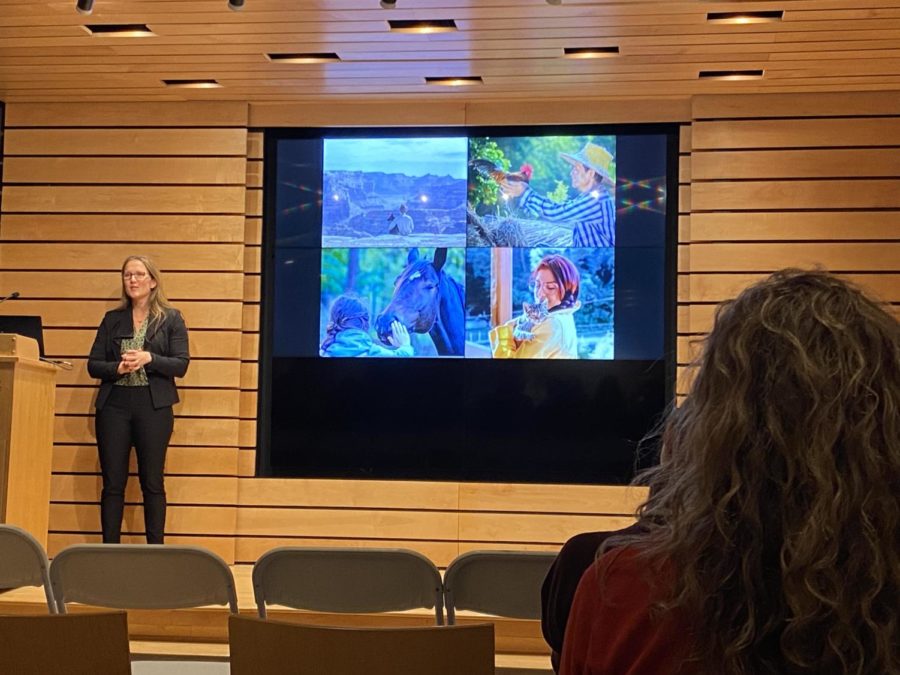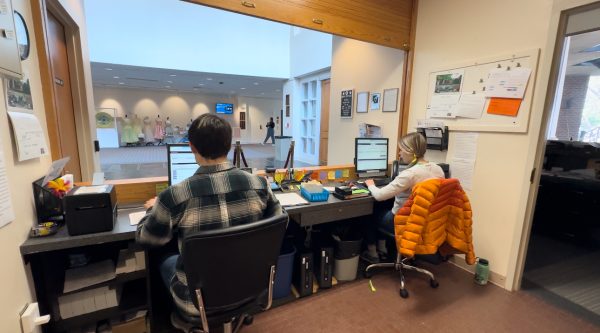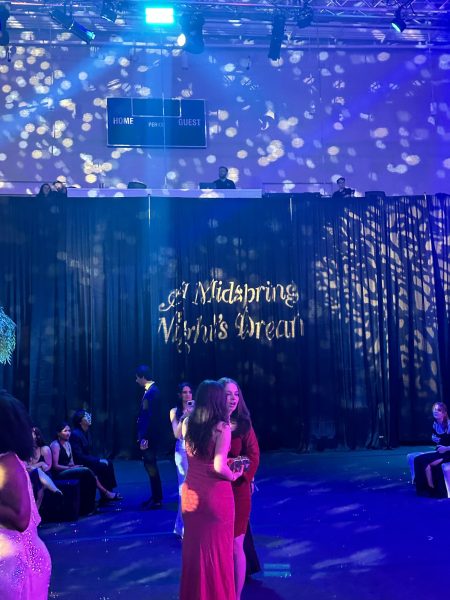Collaborative project encourages students to “paws” and reflect on human-animal relationships
“Compassion and Connection Across Species” lecture links Mudd Center for Ethics, Museums at W&L and University Library
Mueller lectures on the complexity of human-animal relationships.
November 15, 2022
On Nov. 9, the Mudd Center for Ethics hosted Megan Mueller, an associate professor of human-animal interaction at Tufts University and developmental scientist, for a lecture on the psychology of human-animal relationships.
The lecture, which was held in Northen Auditorium, is the Mudd Center’s latest installment in its 2022-2023 theme of “Beneficence: Practicing an Ethics of Care.”
Mueller, who also directs the “Paws for People” therapy animal program and the Tufts “Pets and Well-being” Lab, was invited by Washington and Lee to complement the University Library’s CareLab pet project and the Watson Galleries’ current “Museum Menagerie” exhibit.
“Animals have been part of our lives for tens of thousands of years,” said Mueller as she started her presentation. “They play a large part in our identity and communities.”
Mueller went on to explain the bond between humans and animals as a “mutually beneficial and dynamic relationship” that is easily appreciated but very difficult to conceptualize.
The difficulty comes in part from the large variety of contexts in which humans and animals interact, Mueller said.
“Animals play a lot of different roles in our lives,” she said. “They are our companions, our entertainment, working animals, integral parts of our agriculture and economic system, wildlife and more. We conceptualize animals differently based on all of these different roles.”
The easiest human-animal interaction to study, Mueller said, is the one that humans have with their household pets, commonly dogs and cats. Mueller pointed out that humans tend to choose pets that respond to their voices and are similar to them in temperament.
Humans also have a tendency to anthropomorphize, or assign human behaviors and emotions, to their pets. This phenomenon, Mueller said, is because it is easier to develop empathy for a being that one can relate to.
Mueller asked the audience to write down what emotions and feelings they felt when thinking of a childhood pet. The word that appeared the most was “love,” followed closely by friendship, joy, home, gratitude and family.
This result was expected, Mueller said, and attributed the “warm, cozy” feelings people get from their pets to the strong emotional attachment that forms between a pet and their household.
The emotional attachment is formed as humans rely on their animals for non-judgemental support and physical comfort. As children, many people learn to develop empathy by seeing other perspectives and learn about boundaries through interactions with their pet.
Mueller pulled examples from the library’s CareLab pet project to demonstrate how pets have influenced their owners. The project is a community collaboration between students and staff that asks submitters to share what their pets have taught them about practicing and understanding care along with a photo of said pet.
“Marty has taught me that care is constant and evolving, and often there’s no ‘easy way out’,” read one submission.
“Jack taught me that maintaining absolute dignity is not always worth more than expression of your authentic self,” read another.
These submissions and others were clear signs of the trust, empathy and connection that humans feel towards animals in their “ingroup,” Mueller explained.
The “ingroup” and “outgroup” theory is one way that animal scientists and veterinarians categorize animals that humans interact with, with pets belonging to the “ingroup” and pests, wildlife and animals viewed as food belonging to the “outgroup.”
In a similar fashion to the earlier poll, Mueller invited the audience to write down emotions they associated with wildlife. The words that appeared the most were “fear” and “awe,” with curiosity, danger, distant and misunderstood also being mentioned.
“The ‘outgroup’ is much more distant to us,” said Mueller. “We might respect wildlife, but we also tend to be a little afraid of it.”
Understanding the psychology behind human-animal interactions has become a rising field of study that uses a scientific lens to evaluate the balance of human, animal and environmental health.
A large component of human health is the building of community, which Mueller said can easily happen through animals.
“By providing a shared interest between humans, animals can build the foundation of social relationships between people,” she explained. “Community cohesion can stem from having the same pet, caring for animal welfare or coming together to work on animal-based policy.”
Quantifying human health under the influence of animals, however, does not come without challenges.
“There are a lot of systemic inequities in place that affect people and animals,” Mueller said. “There are systematic differences in how humans and societies prioritize resources, and care for animals can vary wildly across cultures. Context matters.”
To end her lecture, Mueller shared how her relationship with her own dog inspired her work and has guided her understanding of care.
“Because of my dog, I understand why people are so attached to their animals. There’s a real magic there in the relationships we have with our pets,” she said. “I also learned that a lot of animal problems are actually people problems. It’s our perspectives and biases that cause a lot of human-animal conflicts, not the animals.”
At the lecture’s end, the audience was invited to a reception at the nearby galleries, where they could enjoy the colorful animal-themed exhibit of “Museum Menagerie.”
Curated by Patricia Hobbs, senior curator of art and history at Washington and Lee, and the museum staff, “Museum Menagerie” is a collection of artwork from four continents and eleven countries that spans three-and-a-half centuries.
The exhibit, which was first opened to the public on Aug. 24, seeks to explore the bonds that humans and animals have shared across history. The exhibit was inspired by the isolation of the pandemic, which was a time when many households adopted pets to provide physical company, emotional support and comfort.
The statement piece, titled “Peaceable Alaska” by artist Rie Muñoz, is a colorful poster print that depicts a small child surrounded by a group of native Alaskan animals including a bear, elk and a fox.
“‘[Peaceable Alaska]’ was not originally going to be included in the exhibit, as it is actually from Hillel’s collection of biblical works,” said Hobbs. “But it was the most interestingly colorful and fun piece that we could find, and it really spoke to the interaction between humans and animals, so it eventually became our centerpiece.”
The exhibit contains paintings, sculptures, decorative pieces and many other representations of animals in depicted through different mediums.
“As someone with a background in printmaking, I’m particularly drawn to the print of the fish. It’s beautiful,” said Hobbs. “But I really couldn’t pick a favorite work — they’re all incredibly interesting and different.”
Each work of art has an animal as the subject matter, and is accompanied by a short description written by summer intern Kaylin Jury, ‘24, of either the depicted animals or the history of the artwork.
“We wanted to take a fun approach to this exhibit and attract more people who might come from outside of artistic backgrounds,” said Hobbs. “Kaylin’s summer work is part of what makes this exhibit so approachable and accessible. Several guests have told me that [the descriptions] made them feel more comfortable interacting with the exhibit, and that was the goal all along.”
Jury researched each piece and chose “lighthearted, fun facts” to highlight for each work of art.
“I had a lot of freedom in choosing which facts to write about,” Jury said. “I really wanted to explore how animals interacted not just with humans, but with each other.”
The description for the “Garden Stools in the form of Elephants” includes the fact that elephants touch other distressed elephants with their trunks to console them, and that elephant mothers are particularly touchy with their children.
Visitors can see the elephants and the rest of the art menagerie at Watson Galleries until Dec. 3.













